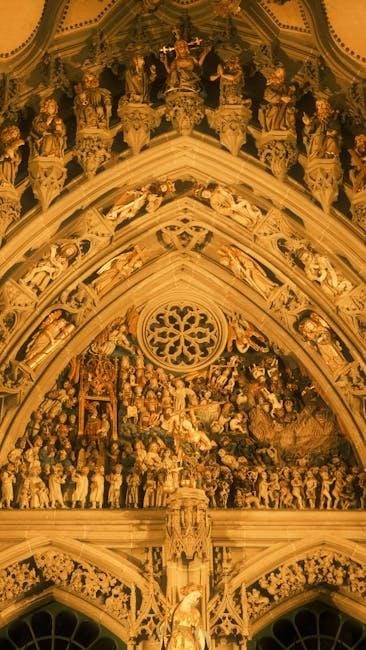Gothic cathedrals represent a monumental style, evolving between the 13th and 15th centuries as modern nations took form. These cathedrals showcase astounding contrast from Romanesque architecture, displaying grandeur and elegance in design.
Characteristics of Gothic Architecture
Gothic architecture, exemplified by French cathedrals like Sens and Notre-Dame, features distinct characteristics that define the style. These include innovative structural elements and aesthetic choices that set it apart from earlier architectural forms.
Pointed Arches and Vaults
Pointed arches and vaults are defining features of Gothic architecture, distinguishing it from the rounded arches of the Romanesque period. This innovation allowed for greater height and more efficient distribution of weight, enabling the construction of taller and more spacious interiors. The pointed arch directs thrust downwards and outwards, but with less lateral thrust than a semicircular arch.
This reduced lateral thrust made it possible to build thinner walls and larger windows. Ribbed vaults, another key element, further enhanced structural stability. These vaults consist of intersecting pointed arches that form a framework, which is then filled in with lighter material. The combination of pointed arches and ribbed vaults created a sense of soaring verticality and openness, hallmarks of the Gothic style. Exeter Cathedral also uses these pointed arches and vaults.
These elements made it possible to create buildings of unprecedented size and scale, pushing the boundaries of architectural possibility during the medieval period.
Stained Glass Windows and Light
Stained glass windows are integral to the Gothic cathedral, serving as both a source of illumination and a medium for storytelling. The large windows, made possible by the structural innovations of pointed arches and ribbed vaults, allowed for an abundance of natural light to flood the interior, creating a sense of ethereal beauty. Sunlight was very important in the construction of the cathedral.
The vibrant colors of the stained glass transformed the light into a kaleidoscope of hues, casting intricate patterns on the walls and floors. These windows often depicted biblical scenes, lives of saints, and other religious narratives, serving as visual aids for the largely illiterate population. The use of light and color was carefully orchestrated to create a sense of awe and wonder, drawing the faithful closer to the divine.
The interplay of light and color, combined with the symbolic imagery, made stained glass windows a powerful tool for religious instruction and spiritual inspiration. The non-linear shape of the windows were created to honor the over 2,000 year old history of the structure.
Emphasis on Verticality and Height
A defining characteristic of Gothic cathedrals is their emphasis on verticality and height, striving to reach towards the heavens. This aspiration was achieved through innovative structural techniques, such as pointed arches, ribbed vaults, and flying buttresses, which allowed for taller and more slender walls. The overall effect was a sense of soaring grandeur, creating an uplifting and spiritual atmosphere.
The towering spires and elongated proportions of Gothic cathedrals were intended to inspire awe and reverence, drawing the eye upwards and symbolizing the connection between the earthly and the divine. The height also served a practical purpose, allowing for larger windows and increased natural light, which further enhanced the sense of spaciousness and luminosity.
The verticality of Gothic cathedrals was not merely an aesthetic choice but a theological statement, reflecting the medieval desire to transcend the limitations of the physical world and reach towards God. The structures became cultural symbols of the time, representing a shift to modern nations with the development of innovative techniques.
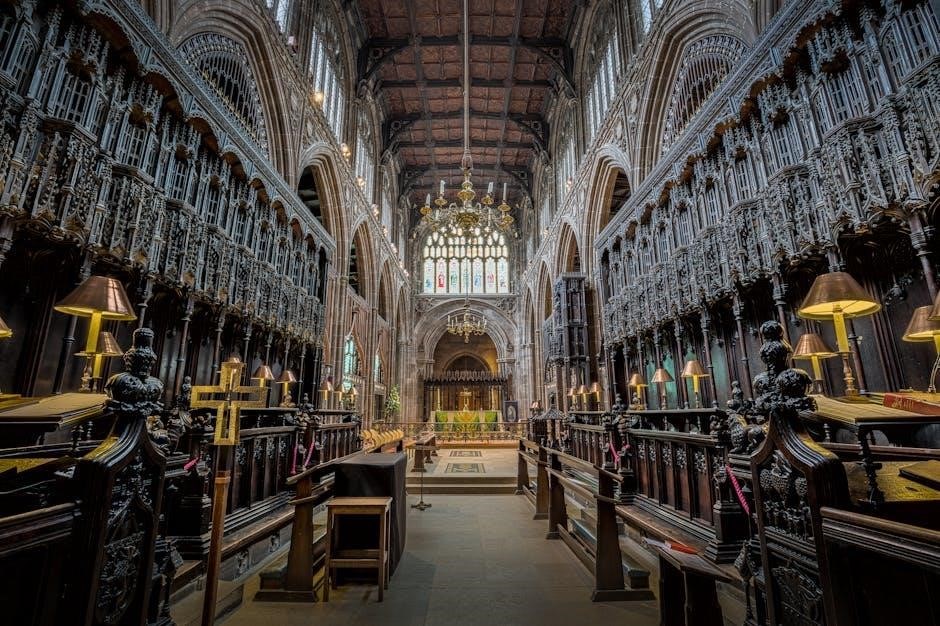
Construction of Gothic Cathedrals
Constructing Gothic cathedrals demanded a skilled workforce of stonemasons, carpenters, and glaziers. Training involved apprenticeships and a culture of quality. The imaginary cathedral of Chuti-eaux reflects actual construction methods.
Skilled Workforce and Apprenticeships
The construction of Gothic cathedrals was a complex undertaking that necessitated a diverse and highly skilled workforce. Stonemasons, responsible for shaping and assembling the vast quantities of stone, were central to the process. Carpenters crafted intricate wooden structures, including roofs and scaffolding. Glaziers created the stunning stained glass windows that filled the cathedrals with light and color.
Training was essential to developing the necessary expertise. Apprenticeships played a vital role, with young individuals learning their trades from experienced masters. This system ensured the transmission of knowledge and skills across generations, fostering a culture of quality and craftsmanship. The construction process demanded precision and collaboration, highlighting the importance of skilled labor in bringing these architectural marvels to life.
The success of these projects depended on the dedication and expertise of the workforce, solidifying their place in history.
Materials and Techniques
The construction of Gothic cathedrals relied on a variety of materials, with stone being the most prominent. Limestone, sandstone, and granite were commonly used, each offering unique properties of durability and aesthetics. These materials were carefully selected and transported to the construction site, often from distant quarries.
Innovative techniques were employed to shape and assemble the stone. Masons used specialized tools to carve intricate details and create precisely fitting blocks. Vaulting, a key feature of Gothic architecture, required advanced engineering skills to distribute weight and create soaring interior spaces. The use of pointed arches, another hallmark of the style, allowed for greater height and thinner walls.
These techniques, combined with the skilled craftsmanship of the workforce, resulted in structures that pushed the boundaries of architectural possibility. The materials and techniques used in Gothic cathedral construction were a testament to the ingenuity and resourcefulness of medieval builders, resulting in lasting architectural achievements.
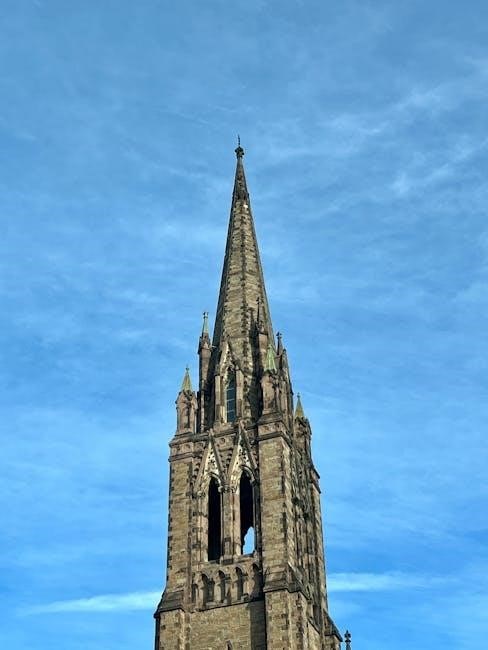
Examples of Famous Gothic Cathedrals
Several Gothic cathedrals stand as testaments to the era’s architectural prowess. These include Amiens Cathedral, a prominent example, Notre-Dame de Paris, and Chartres Cathedral. Each showcases unique features and historical significance.
Amiens Cathedral: A Case Study
Amiens Cathedral, located in France, serves as a compelling case study within Gothic architecture. Its geometrical, constructive, and static analysis reveals remarkable engineering. The cathedral exemplifies High Gothic construction, showcasing the skilled workforce of stonemasons, carpenters, and glaziers involved in its creation.
This cathedral’s design reflects the training, apprenticeships, and culture of quality prevalent during its construction. Its sheer size and architectural details highlight the advanced techniques used. Amiens Cathedral’s intricate structure exemplifies the Opus Francigenum, representing French Gothic cathedral architecture at its finest.
Exploring Amiens Cathedral provides insights into the construction methods and artistic vision of the Gothic period. It stands as a testament to the era’s innovation and dedication to architectural excellence, remaining a significant historical and cultural landmark that continues to inspire awe.
Notre-Dame de Paris
Notre-Dame de Paris, a prominent example of French Gothic architecture, holds significant historical and cultural importance. Victor Hugo viewed its façade as an architectural page, symbolizing national unity. As an Opus Francigenum cathedral, it embodies the artistic and engineering achievements of the Gothic period.
The cathedral’s construction reflects the skilled workforce and intricate techniques of the time. Its design, with pointed arches and vaults, showcases the era’s emphasis on verticality and light. Notre-Dame’s stained glass windows contribute to its ethereal beauty, creating a spiritual atmosphere within its walls.
Despite facing challenges, including damage from fire, Notre-Dame de Paris remains an iconic symbol of France. Its ongoing restoration represents a commitment to preserving its architectural heritage. The cathedral’s legacy continues to inspire and captivate, embodying the grandeur and elegance of Gothic institutions.
Chartres Cathedral
Chartres Cathedral, a magnificent example of French Gothic architecture, stands as a testament to medieval artistry and engineering. As an Opus Francigenum cathedral, it showcases the innovative techniques and aesthetic principles of the Gothic period. Its dedication to the Virgin Mary reflects the era’s deep religious devotion.
The cathedral’s stained glass windows are renowned for their vibrant colors and intricate designs, filling the interior with ethereal light. The pointed arches and vaulted ceilings exemplify the Gothic emphasis on verticality and height, creating a sense of awe and spiritual transcendence. These elements contribute to Chartres’s unique atmosphere.
Chartres Cathedral’s construction involved a skilled workforce, including stonemasons, carpenters, and glaziers, demonstrating the importance of training and craftsmanship. The cathedral’s enduring presence symbolizes the cultural and religious significance of Gothic architecture. It inspires visitors with its beauty and historical importance.
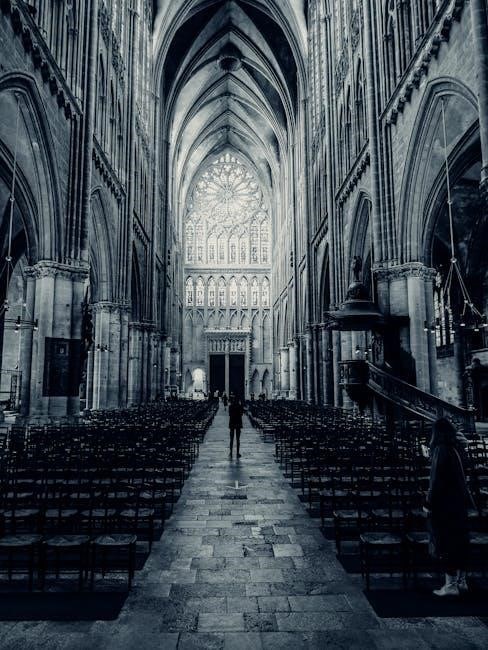
Gothic Cathedrals and Virgin Mary
Gothic cathedrals hold a profound connection to the Virgin Mary, reflecting her significance in medieval religious life. Many of the most influential cathedrals were dedicated to her, honoring her role as the mother of Jesus and a symbol of compassion. This dedication is evident in their architecture, art, and overall symbolism.
The association with the Virgin Mary is linked to her perceived suffering and empathy, making cathedrals dedicated to her places of solace and reflection. The emphasis on light and beauty within these cathedrals can be seen as a representation of her purity and grace. Stained glass windows often depict scenes from her life.
The grand scale and intricate details of these cathedrals serve as a testament to the devotion and reverence felt towards the Virgin Mary. They symbolize a spiritual aspiration and a connection to the divine. Gothic cathedrals embody the era’s deep faith. They celebrate the Virgin Mary’s enduring influence.
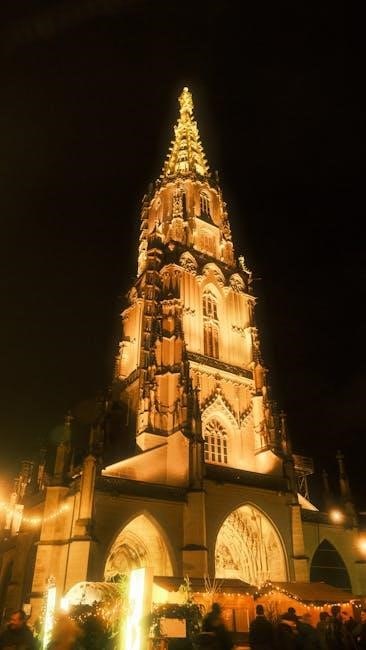
The Symbolism and Meaning of Gothic Cathedrals
Gothic cathedrals are rich in symbolism, representing a complex interplay of religious, social, and architectural ideas. These structures were designed not only as places of worship but also as visual representations of the medieval worldview. Every element, from the soaring heights to the intricate carvings, carries a specific meaning.
The verticality of Gothic cathedrals symbolizes the aspiration towards heaven and the divine. The pointed arches and vaults direct the eye upwards, encouraging a sense of spiritual transcendence. Light, streaming through stained glass windows, represents divine illumination and the presence of God. The elaborate sculptural programs depict biblical stories and moral lessons.
Gothic cathedrals served as community centers, reflecting the social and cultural values of the time. They were places of learning, art, and civic engagement. The construction of these cathedrals required a skilled workforce. It fostered a sense of collective identity and pride. Gothic cathedrals are testaments to the era’s deep faith.
